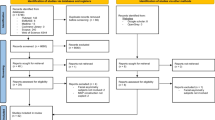Abstract
Objectives
The aim of this study was to create an evidence-based three-dimensional cephalometric analysis of orbits in order to perform time-efficient measurements of postoperative orbital morphology changes.
Materials and Methods
The authors used 23 (11 bilateral and 1 unilateral) anatomical landmarks. Based on these, 6 planes, 12 angular and 16 linear measurements were determined. A three dimensional analysis was performed twice by two observers on pre and post-operative computed tomography scans of six patients who had undergone midface advancement. The mean, minimal and maximal difference, as well as standard deviation (SD) and intraclass correlation coefficient (ICC) for the inter- and intra-observer landmark selection reliability were calculated. Additionally, the mean, minimal, maximal difference and standard deviation between pre- and post-operative angular and linear measurements were calculated to examine a connection between the established measurements and any morphological change.
Results
The inter and intra-examiner accuracy of all landmarks for three axes was >0.9 ICC. Despite excellent inter and intra-examiner agreement (<2.49 mm ± 2.05 mm SD) for the landmark selection, linear and angular measurements showed a mismatch, the mean SD for angular measurements was found to be 8.2° and the linear 3.04 mm.
Discussion
The possible causes of linear and angular measurement discrepancies are discussed and the future direction for the development of three-dimensional cephalometric analysis of orbits proposed.


Similar content being viewed by others
References
Forte AJ, Alonso N, Persing JA, Pfaff MJ, Brooks ED, Steinbacher DM (2014) Analysis of midface retrusion in Crouzon and Apert syndromes. Plast Reconstr Surg 134:285–293
Forrest CR, Hopper RA (2013) Craniofacial syndromes and surgery. Plast Reconstr Surg 131:86e–109e
Chin M, Toth BA (1997) Le Fort III advancement with gradual distraction using internal devices. Plast Reconstr Surg 100:819–830
Posnick JC, Ruiz RL (2000) The craniofacial dysostosis syndromes: current surgical thinking and future directions. Cleft Palate Craniofac J 37:433
Gosain AK, Santoro TD, Havlik RJ, Cohen SR, Holmes RE (2002) Midface distraction following Le Fort III and monobloc osteotomies: problems and solutions. Plast Reconstr Surg 109:1797–1808
Nout E, van Bezooijen JS, Koudstaal MJ, Veenland JF, Hop WC, Wolvius EB, van der Wal KG (2012) Orbital change following Le Fort III advancement in syndromic craniosynostosis: quantitative evaluation of orbital volume, infra-orbital rim and globe position. J Craniomaxillofac Surg 40:223–228
Khonsari RH, Friess M, Nysjö J, Odri G, Malmberg F, Nyström I, Messo E, Hirsch JM, Cabanis EA, Kunzelmann KH, Salagnac JM, Corre P, Ohazama A, Sharpe PT, Charlier P, Olszewski R (2013) Shape and volume of craniofacial cavities in intentional skull deformations. Am J Phys Anthropol 151:110–119
Hoffman WY, McCarthy JG, Cutting CB, Zide BM (1990) Computerized tomographic analysis of orbital hypertelorism repair: spatial relationship of the globe and the bony orbit. Ann Plast Surg 25:124–131
Imai K, Fujimoto T, Takahashi M, Maruyama Y, Yamaguchi K (2013) Preoperative and postoperative orbital volume in patients with Crouzon and Apert syndrome. J Craniofac Surg 24:191–194
Kwon J, Barrera JE, Jung TY, Most SP (2009) Measurements of orbital volume change using computed tomography in isolated orbital blowout fractures. Arch Facial Plast Surg 11:395–398
Lukats O, Vízkelety T, Markella Z, Maka E, Kiss M, Dobai A, Bujtár P, Szucs A, Barabas J (2012) Measurement of orbital volume after enucleation and orbital implantation. PLoS One 7:e50333
Smektała T, Jędrzejewski M, Szyndel J, Sporniak-Tutak K, Olszewski R (2014) Experimental and clinical assessment of three-dimensional cephalometry: a systematic review. J Craniomaxillofac Surg 42(8):1795–1801
Shahidi Sh, Oshagh M, Gozin F, Salehi P, Danaei SM (2013) Accuracy of computerized automatic identification of cephalometric landmarks by a designed software. Dentomaxillofac Radiol 42(1):20110187
Vucinić P, Trpovski Z, Sćepan I (2010) Automatic landmarking of cephalograms using active appearance models. Eur J Orthod 32:233–241
Silveira HL, Silveira HE, Dalla-Bona RR, Abdala DD, Bertoldi RF, von Wangenheim A (2009) Software system for calibrating examiners in cephalometric point identification. Am J Orthod Dentofacial Orthop 135:400–405
Funding
None.
Author information
Authors and Affiliations
Corresponding author
Ethics declarations
Conflict of interest
None.
Ethical Approval
This article does not contain any studies with animals performed by any of the authors. All procedures performed in study involving human participants were in accordance with the ethical standards of the institutional and/or national research committee and with the 1964 Helsinki declaration and its later amendments or comparable ethical standards. Local ethics committee number 27/2013/V.
Informed consent
Informed consent was obtained from all individual participants included in the study.
Rights and permissions
About this article
Cite this article
Smektala, T., Staniszewska, E., Sławińska, A. et al. Three-Dimensional Cephalometric Analysis of Orbital Morphology Modification for Midface Correction Surgery. J. Maxillofac. Oral Surg. 15, 285–292 (2016). https://doi.org/10.1007/s12663-015-0837-7
Received:
Accepted:
Published:
Issue Date:
DOI: https://doi.org/10.1007/s12663-015-0837-7




